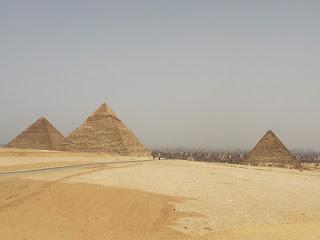 When it comes to archaeological sites, the Great Pyramid at Giza is the gift that keeps on giving. 5000 years after the massive structure was first built, it continues to reveal its secrets. Case in point, yesterday researchers revealed that they had discovered a hidden chamber – described as a "void" – inside the Pyramid that is at least 100 feet (30 meters) in length.
When it comes to archaeological sites, the Great Pyramid at Giza is the gift that keeps on giving. 5000 years after the massive structure was first built, it continues to reveal its secrets. Case in point, yesterday researchers revealed that they had discovered a hidden chamber – described as a "void" – inside the Pyramid that is at least 100 feet (30 meters) in length.This opening inside the Great Pyramid is the first to be discovered since the 1800's and was only now located through the use of high-energy particles. The process involves scientists tracking a sub-atomic particle known as a muons as it passes through the ancient building. Muons are present in comic rays, and are only partially absorbed by stone. By tracking the movement of this particles, archeologists can get a picture of sorts of the structure using radiography. It was through this process that the new chamber was located and identified.
According to reports, the newly located opening inside the Great Pyramid is roughly the size of the Grand Gallery, which is where the body of the Pharaoh Khufu was entombed. That room is roughly 153-feet (46 meters) in length and 26-feet 8 meters) tall. It's discovery has stunned scientists, who thought they had mapped every corner and crevice inside they Pyramid.
It should be noted that the researchers who found this blank spot on the Pyramid's muon map are being careful to not call the void a chamber as of yet. They are hoping to collect more data before jumping to too many conclusions. Still, experts have begun to speculate on what it could be, with some suggesting that it is a left over structure from when the Pyramid was first built. Perhaps a ramp that was used to place the large stones that make up the monument into place. It could also be an internal frame that relives pressure on the lower sections of the building too.
For now, we'll just have to wait for the results of more scans and research. It could be years – if ever – before archeologists truly know what the void is. But, it is definitely exciting to see new discoveries thousands of years after the Great Pyramid was first built.

